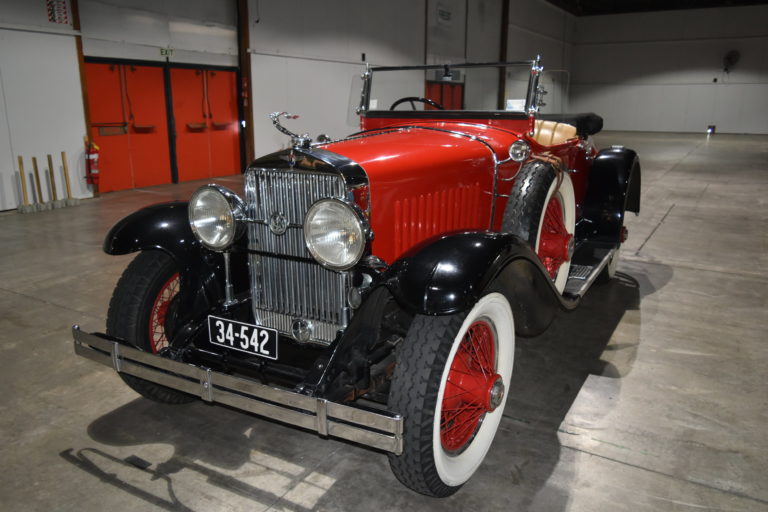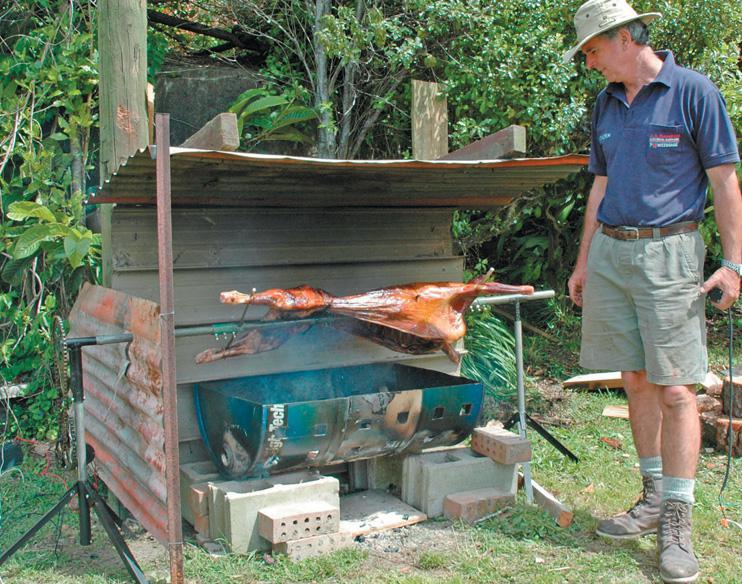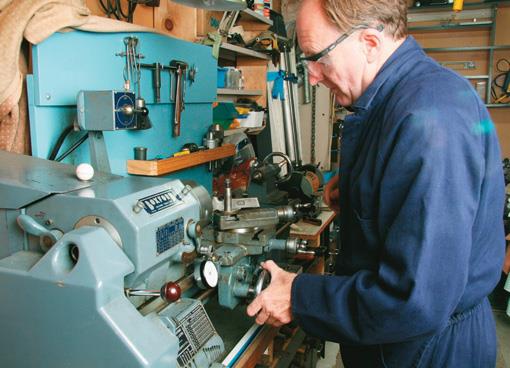Latest news and features

Size matters, but so do good looks
Philip Solomon has years of experience putting up large sheds and his top tip is that shed aesthetics are important.“A lot of people just focus on what they want to put in the shed until it goes up and then they say, ‘Oh, I don’t like that’,” he says.

The Shed January/February 2020, Issue 88, in shops now
For many of us Kiwis, summertime can mean it’s time to dig out the family tractor. Because summer means beach-holiday time and using that good-old-boy tractor to get the fishing boat in the water as often as possible. To celebrate our love of old tractors, we head south to meet a tractor restorer from Oamaru, one Colin Harvey, who has shedfuls of tractors and spends all his time tinkering with and restoring some great classic farming workhorses.

High time for high shine
The world-famous Autosol Metal Polish is available in an easy-to-use liquid formulation. It’s perfect for cleaning and protecting all metal surfaces on cars, boats, bikes, and around the home.

Different Tusks for different tasks
Tusk offers three ranges of drills made from different grades of high-speed steel. Tusks metal drill bits are made from M2 high-speed steel with a titanium nitride (TiN) coating. The 135-degree point offers faster drilling, lower feed pressure and they have a split point or self-centering tip.

Autosol Metal Polish
If you haven’t heard of Autosol, you have to try it. This incomparable metal polish has won three international gold medals and is recommended by manufacturers and restoration experts around the world. Autosol Metal Polish safely and easily removes oxidation, corrosion, stains and rust

Make your own Kontiki for fishing
There are several New Zealand-designed and created fishing kontikis on the market but when I thought about having one, I wasn’t going to buy it.
I had the ability, so I did what any good Kiwi would do, I decided I would make one myself.

Refurbishing my bench plane
The metal-based hand plane must be one of the most enduring and useful tools in the kit of any aspiring woodworker.
Those of us who take the hobby a little more seriously will have several of them and we will probably argue that we use them all. I have six or seven but have never bought one.

Build a tipping trailer
When I first looked at building a tipping trailer, I wondered whether I would be building a trailer with a hydraulic cylinder under it, or fitting a hydraulic cylinder under a trailer. After due consideration, I realised that a trailer is a trailer, regardless of the frills.

Climate control
As a project, a weather station is a great one for beginners and advanced woodworkers alike. It can be as simple as taking a really attractive piece of timber, sanding and finishing it to a high degree (even leaving the edges natural) and attaching one or more brass instruments to the surface.

Homemade bench holdfast
A bench needs clamps, a second pair of hands to hold the work still and stable.
Traditionally, woodworkers have used a holdfast and the most popular of these was the Record holdfast, now sadly out of production.

Photos from the Very Vintage Day out show – 2019
This event is a fun occasion for all lovers of the vintage lifestyle and 1000s enjoyed a great day of vintage paraphernalia, entertainment, and vendors at the ASB Showgrounds in Auckland October 19.

Photos from the 2019 Auckland Blade Show
This years’ show was held at the same venue as last year in the historic Parnell Comunity Centre at 545 Parnell Road on the weekend of 12 and 13 October.
Here are over 50 photos of the amazing Kiwi knifemakers’ products on display at the show. Keep an eye out for a full show report in the next issue of the magazine on sale in December.

Weaving willows
Of the scores of varieties of willow commonly used in basket weaving, six grow on a 1000-square metre plot at the back of Mike Lilian and Annemarie Liesbeth’s house in the coastal settlement of Kakanui, 15 minutes drive south of Oamaru.
Mike has been making and selling willow baskets in dozens of styles since 1985.

When everything goes right
David Thompson is a builder. When he wanted a new shed big enough to fit a car hoist you’d imagine that he would knock one up himself. Not so.

The balisong or folding knife
The balisong, also erroneously called the butterfly knife, has been around since approximately 1200 BC where it played a part in the Filipino martial art form, Escrima.
Although some commercially available ones have been around for many years, they never really caught on until the 1970s.
I know one knife-maker in NZ who makes balisongs exclusively. The reason for the balisong’s popularity: four pins, two handles, one blade. No springs, screws, rivets.

The Shed, November/December 2019 issue no 87, in shops now
The November/December 2019 Issue 87 of The Shed, has a real electronics feel about it but there is also a lot here to keep all sheddies informed, entertained and well-skilled up.
Our cover story is about the goal of a Christchurch boat builder, architect, designer, sailor, Quentin Roake, to find a way to build waka in large numbers. He wants to recreate the appearance and characteristics of traditional craft in a modern version that is portable, durable, and economical to manufacture. Quentin has made it his mission to put Maori waka back on the water by marrying traditional knowledge with today’s technology

Wa-ter rocket!
A pretty simple water rocket launcher using a few high-pressure PVC plumbing pipes, air and a soft-drink bottle with water in it will provide plenty of DIY fun and show some basic physics.
I built one for my eight-year-old’s Cub Scout group and have had lots of requests from fathers asking how to make one.

On a scroll
Once, while browsing through an old wrought-iron design catalogue, Kim (the son of blacksmiths Ian Nielsen & Son) came across a peacock design and decided it would make a great after-hours project. It turned into a much bigger job than he anticipated with the finished 3 metre by 2 metre gate taking around a ton of steel and about three months to make.

Christchurch Woodturners Association
On Saturday, 24 August 2019, the Christchurch Woodturners Association (CWA) finally saw its long-term dream come to fruition with the opening of its very own clubrooms on the Auburn Ave Reserve in Upper Riccarton.

This quick fix Liquid Nails is impressive
We thought you would find this video interesting to watch. It shows the impressive strength of Instant Hold Liquid Nails from Selleys – it’s a pretty quick fix.

Getting a handle on veneer
This piece was originally designed as a bit of fun: a simple carcase construction with a handle detail that would provide me with a challenge while satisfying my passion for curvy, organic forms. I made the original version in maple with a bloodwood veneer. The contrast in timber and the handle detail made for a striking piece and I was commissioned to make another in cherry with birdseye maple veneer.

From scrap metal to cooking spit
It’s not my original idea. I used to live in Tutukaka and we’d go on 4WD rallies and claybird shoots in the backblocks where there was no power. It was a lot of fun. One time a guy turned up with a battery-driven spit and the idea stayed in my mind. You could take it where there was no power – I always said I would design something one day that worked with no power.

Recycle don’t bin that wrapper
This may interest you if you’re a Shed subscriber.
Did you know that the plastic wrapping that acts as an envelope for your home-delivered copy of The Shed is recyclable?

The Shed Issue 86 on sale nationwide in Australia today
Good news for our Australian readers of The Shed.
The September/October 2019 issue is on sale from today at your favourite magazine retailer. Click on the link below to find your nearest store or head to https://magstore.nz/ to purchase a copy or to subscribe to a print or digital version of the magazine.
https://the-shed.nz/home/2018/9/5/find-your-local-australian-the-shed-retailer

How to make a knife video by Josh Timmins from Issue 86
Meet the knifemaker from The Shed Issue 86 and watch how he makes a fully forged knife in his Whanganui shed

Carve a Tudor rose
An aspiring woodcarver who builds on a solid foundation of knowledge and technique will soon be creating impressive carvings. To demonstrate basic knowledge and techniques, we are going to follow the carving of a Tudor rose.

Colour anodise that aluminium alloy
Aluminium alloys have one critical failing, for all their good qualities of lightness, conductivity and strength. They corrode. One way to guard against corrosion is to create a hard oxide film on an aluminium alloy by anodising

The Shed Magazine, 2020 calendar competition
We are looking for twelve great shed shots for our first ever The Shed calendar. This calendar will be included with all subscriber and New Zealand retail copies of the January/February 2020 issue, on sale December 2 2019.

The bronze age
Brought up in a family of artists, Rudi Buchanan-Strewe has tried to break the mould and, after work experience as a blacksmith, he completed a motorcycle apprenticeship at Classic Cycles in Upper Hutt. A move back to Auckland saw him working for Ken McIntosh on his Manx Nortons before deciding, about eight years ago, to give in to his genes and pursue his love of sculpture.

Trade profile – Kiwispan
Shannon Jordan and Louise Simmons sold up in suburbia and bought a block of land in Ruakaka, Northland, three years ago. They planned to live in a caravan while planning and saving for their house. From this magazine’s point of view, they had their priorities right and decided to build a shed first.

Lathe stop prevents scrap
I think most turners get frustrated with constantly having to stop the lathe and measure and re-measure the length along the bed as the work gets reduced.

No one regrets buying quality
Now with new, lower pricing
Honda’s inverter generators are famous for their reliability, fuel efficiency and portability but they also supply ‘clean’ power for phones, laptops and power tools. Older generators can produce power spikes or variable voltages that can damage modern appliances.

Big drill bits for every drill
Tusk HRS drill bits, made from M2 high-speed steel also have a titanium nitride coating for longer life. Their 135-degree tip offers a faster drilling rate and lower feed pressure.

The Shed, September/October 2019 Issue 86, on sale now
In the October/ November Issue 86 of The Shed, we first head to Whanganui to meet blacksmith Josh Timmins.
Josh has his own way of making knives and axes and shows us how to make a Viking Knife starting with a piece of new steel right through to the finished product.
Then we head to…

Build your own LPG-powered forge video
This brick forge is constructed from lightweight insulating firebrick. Known as a K26 brick it is available from Certec in Auckland.
These insulating fire bricks are rated to 1426°C and measure 230x115x75mm. They are commonly used to line foundry furnaces, forges, and kilns. These soft bricks can easily be cut to size with an ordinary wood saw, drilled to create burner openings, or routed to create channels.
Watch this video to see how we built this gas forge and an oil-powered version as well.
As featured in The Shed Issue 85

A silver butterfly takes wing
If this design was being made in an art school, it would be stuck to a sheet of silver and the basic shapes cut from there. If a design was made this way in, say, 18 carat gold and the wing outlines (as here) made from 2.5mm thick metal, the outlay and waste material would be considerable from a 2.5mm-thick sheet of 18 carat gold plate. But we will make it like a professional craftsman who has to live in the real world where costs matter.

Making a word clock
The Word Clock is a project created by Doug Jackson using Open Source (www.dougswordclock.com) and has been evolving into the product you see here.
It is based on an Atmel 168 processor chip as used in Arduino, is programmed using Arduino and fitted into a custom-made printed circuit board (PCB).

A bowl with a decent bark
The best timber for this kind of bowl is any fruit tree, the flowering cherry tree, olive tree or any tree with not too thick bark. Pohutukawa is a good wood, but the bark is fragile.
The secret to capturing this natural-edged look is to turn the bowl from a piece of timber that has not yet totally dried out.

Water power on the up
The first water ram was patented in 1772 by Englishman John Whitehurst. Designs have evolved since then and continue to do so particularly in Holland where, in the 1990s, one university was building 20 water rams a year for third-world projects.
